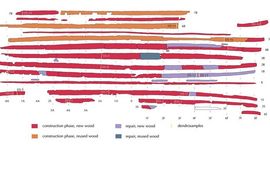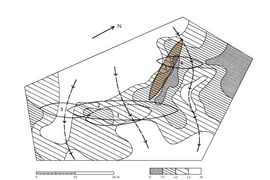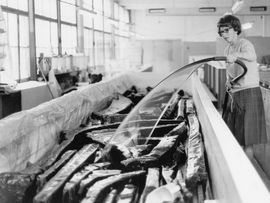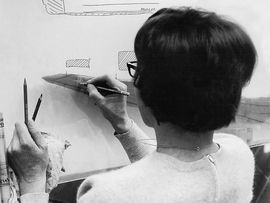The ship-find
Skuldelev 5 is what we call a ship-find, rather than a shipwreck, and there's a good reason for that. Skuldelev 5 did not end up at the bottom of Roskilde Fjord because it went down in stormy weather. Together with the four other Skuldelev ships, Skuldelev 5 was deliberately sunk to create a barrier out on the fjord.
The barrier in Roskilde Fjord
The barrier was probably established either to protect the city of Roskilde from attacks from the sea or to control ship-traffic in and out of Roskilde. It was built in three stages. In the first phase, around 1060-70, Skuldelev 1, Skuldelev 3 and Skuldelev 5 were towed out onto the fjord and sunk across the channel that today is known as 'Peberrenden'.
Some years later, the barrier was further reinforced with two additional ships, Skuldelev 2 and Skuldelev 6, presumably because the first three ships had begun to fragment due to the effects of water and weather. In the final phase, some large posts were added to the area around the barrier.
Random location
All five ships were well-used and worn when they were sunk. All loose parts – deck, rudder, mast, sail, rig and oars – had been removed, so that only the hulls themselves were used for the barrier.
Skuldelev 5 was set on the north side of the sailing channel. It is at a slightly odd angle compared to both the channel and the other two ships, perhaps because the ship ran aground in the wrong place and was too cumbersome to move into place, so they probably just took out the bottom plug and let the ship fill up with water.
The ship quickly settled down on the port side, which meant that the starboard side was particularly exposed to the current and was probably quickly broken down. A few years later, Skuldelev 6 was sunk on top of Skuldelev 5, which stopped the biological decay of the remaining parts of Skuldelev 5's hull.
Salvaging and documentation
Excavation of all five ships took place over the summer of 1962. All of Skuldelev 5's ship parts – 270 units in total – were salvaged over 7 working days. Each individual component was documented in 1:1, and all details such as toolmarks, rivet holes, cracks, breaks, profiles, edges, etc. were drawn in on transparent foil. After documentation, all components were conserved before the final process of reconstructing the ship's form for exhibition could begin.
Complex puzzle
Reassembling a ship-find after several hundred years underwater is a complicated process. The parts may have been deformed due to the profile of the seabed or the many rocks used to sink the ships. Long components such as planking material or keels may have been broken up into many small pieces. It is therefore a large and complex puzzle, investigating ship-finds with a view to reconstruction so they can be exhibited.
Facts about Skuldelev 5
Skuldelev 5 is relatively well preserved as archaeological ship finds go. Although very little of the starboard side has survived, and the aft section is also missing, the remaining ship parts were sufficient to be able to reconstruct the shape and size of the ship:
- Date: c. 1030
- Place of construction: Denmark
- Preserved: Approx. 50 %
- Material: Oak, pine, ash and alder
- Length: 17.3 meters
- Beam: 2.5 meters
- Draught: 0.6 meters
- Displacement: 7.8 tons
- Oars: 26
- Crew: Approx. 30 men
- Sail area: 46 m2
![[Translate to English:] Vikingeskibsmuseets bådeværft er i gang med et eksperimentalarkæologisk projekt - en fuldskala rekonstruktion af Skuldelev 5. Arbejdet begyndte i sommeren 2022. [Translate to English:] Vikingeskibsmuseets bådeværft er i gang med et eksperimentalarkæologisk projekt - en fuldskala rekonstruktion af Skuldelev 5. Arbejdet begyndte i sommeren 2022.](/frontend/Grafik/NYskuldelev5_logo_web_banner_555x134_555x393px_01.png)
![[Translate to English:] Kløvning af egestamme til Skuldelev 5 [Translate to English:] Kløvning af egestamme til Skuldelev 5](/frontend/_processed_/1/3/csm_2023_06_06_12_13_48_WK_3f82264310.jpg)
You can also get regular updates from the project on the Museum's Instagram profile:
» Visit us on Instagram...
See regular photo and film updates on Facebook:
» Visit us on Facebook...
We are we reconstructing?
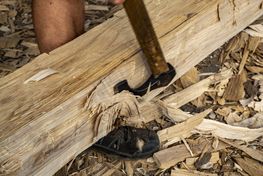
By reconstructing the Viking Ships, we gain insight into the craftsmanship and traditions of the Viking Age, and the original function and sailing abilities of the ships.
The build in pictures
![[Translate to English:] Skuldelev 5 - stævn [Translate to English:] Skuldelev 5 - stævn](/frontend/_processed_/d/2/csm_2023_06_20_14_26_01_WK_bf6c948f9e.jpg)
We continuously document the reconstruction of Skuldelev 5. You can follow the build in pictures in our gallery.
» Take a look..
